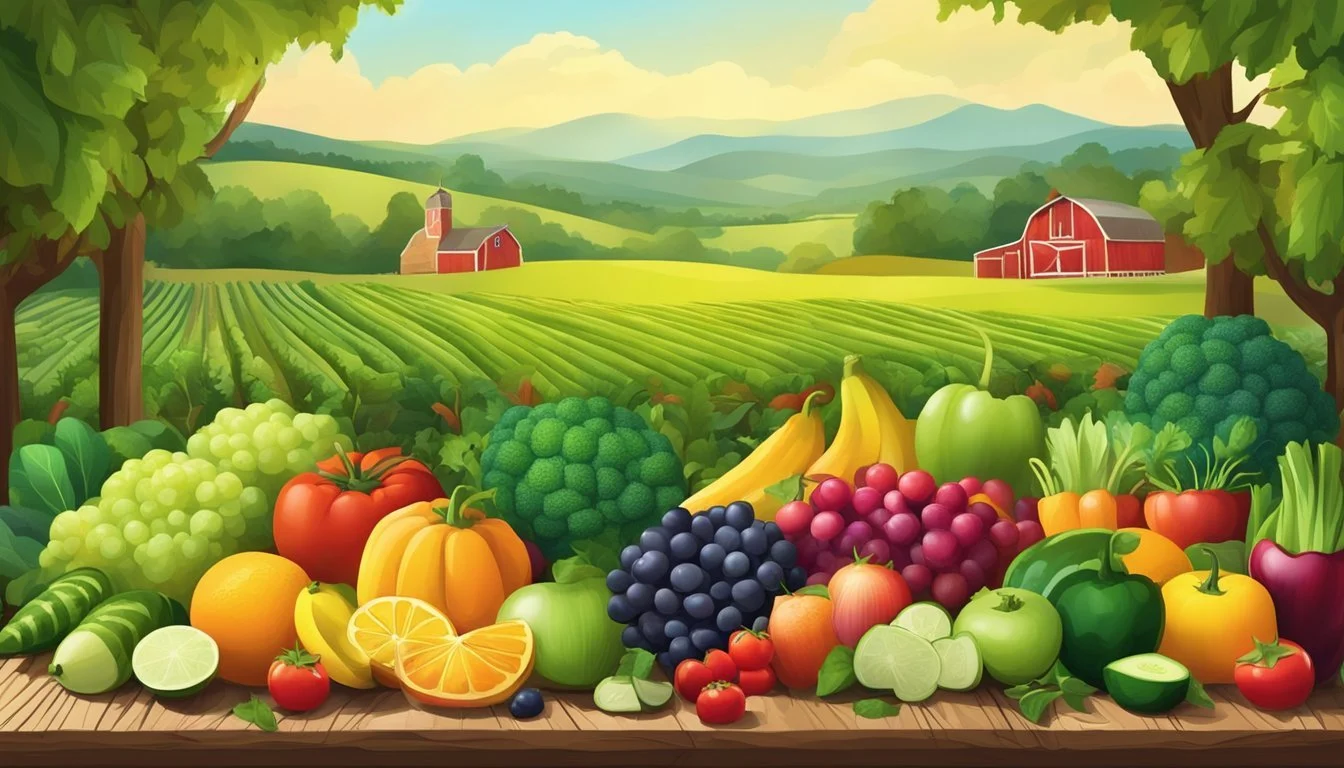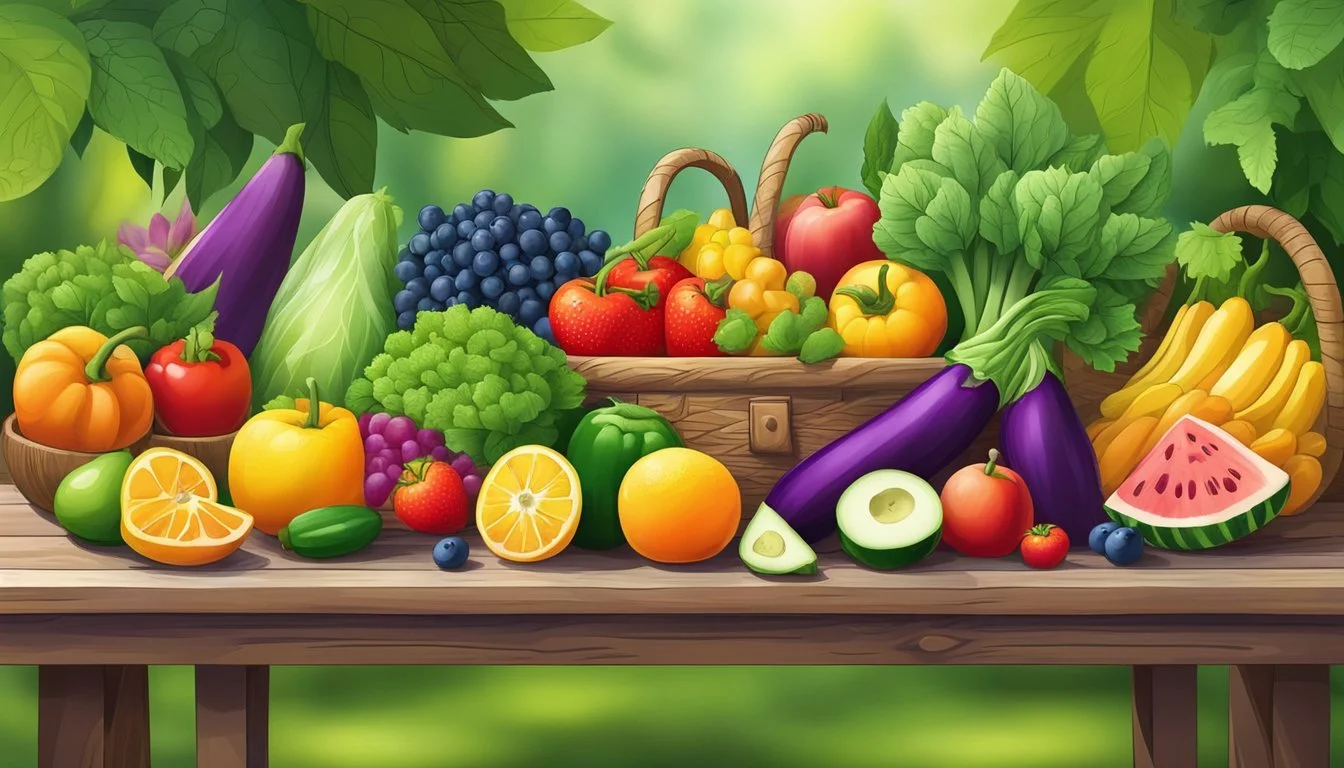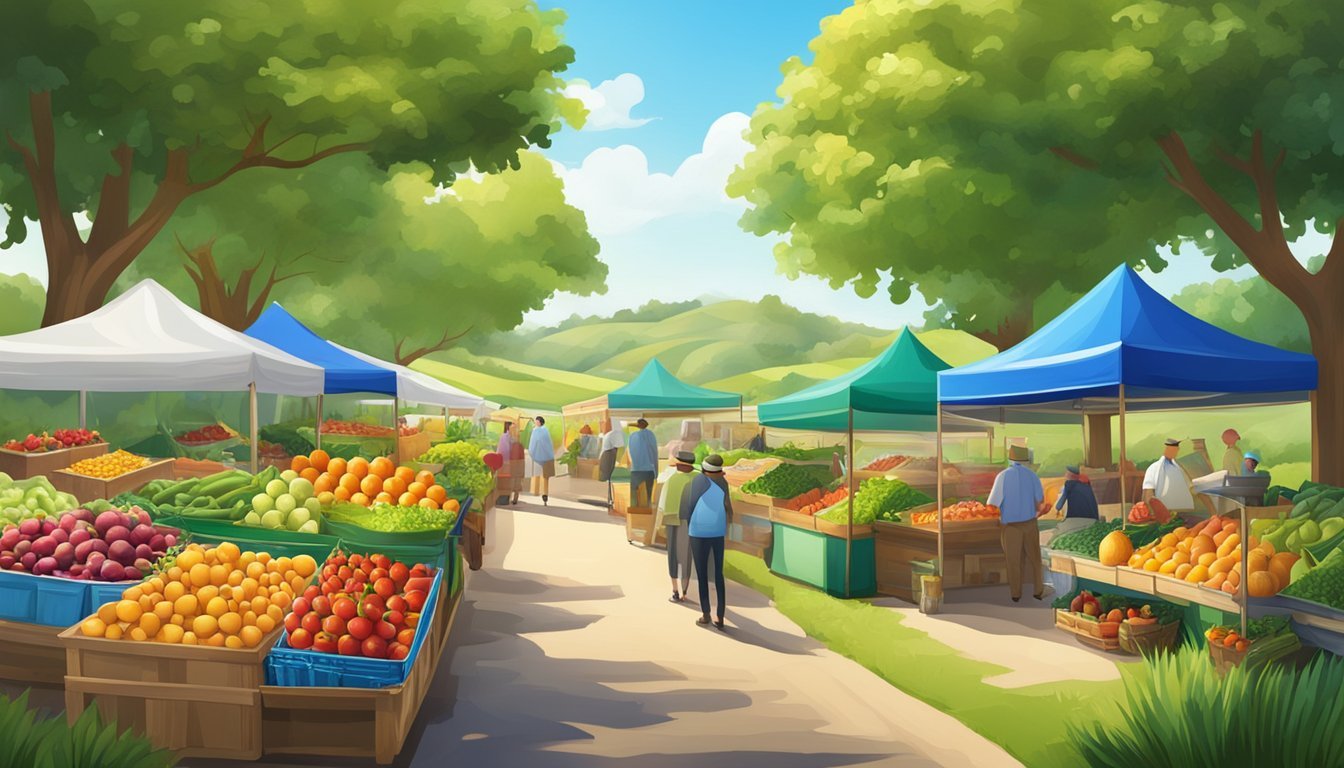Mississippi Seasonal Fruit & Veg Guide
Your Essential Calendar
In Mississippi, the farm to table movement is flourishing, bringing fresh, locally-grown produce to the forefront of the culinary scene. Seasonality is key in this endeavor, with various fruits and vegetables ripening at different times throughout the year. Consumers who are attuned to the rhythm of the seasons can enjoy the freshest flavors while supporting local agriculture. The concept is simple: eat produce when it's at its peak of freshness and when nature intended it to be harvested.
The state boasts a generous growing season, thanks to its temperate climate, which allows a wide variety of produce to thrive. In the spring, one can expect tender asparagus and strawberries, while the summer months are synonymous with juicy tomatoes, sweet corn, and an array of stone fruits. Come fall, apples and sweet potatoes (What wine goes well with sweet potatoes?) take center stage, and even in winter, the fields yield a bountiful harvest of greens and root vegetables.
Understanding and utilizing a Mississippi produce calendar is crucial for anyone looking to engage with farm-to-table dining. It not only ensures that consumers are getting produce packed with optimal flavor and nutrition, but it also fosters a deeper connection to the local food system and its seasonal cycles. This knowledge empowers Mississippians to make informed choices that benefit both their health and their local economy.
What’s in Season in Mississippi Right Now?
Understanding Seasonal Produce in Mississippi
Mississippi's diverse climate allows for a wide range of fruits and vegetables to grow throughout the year. This section offers insights into the benefits of seasonal eating and the influence of Mississippi’s weather on its agricultural bounty.
Benefits of Seasonal Eating
Consuming produce that is in season in Mississippi not only supports local agriculture but also ensures that individuals are getting the freshest and tastiest fruits and vegetables. Freshness is at its peak shortly after harvest, which translates to higher nutritional content and better flavor. Seasonal eating helps in sync with nature's production cycle, promoting environmental sustainability by reducing transportation and storage.
Overview of Mississippi's Climatic Influence on Agriculture
Mississippi’s climate, classified as humid subtropical, is characterized by long, hot summers and short, mild winters. This climate significantly affects the type of crops that can be grown and when they can be planted and harvested. For instance:
Spring: Mississippi soils warm up early, making it suitable for asparagus and various beans to be sown and harvested in this season.
Summer: Characterized by high temperatures, summer is ideal for crops like tomatoes, sweet corn, and an array of berries that thrive in the heat.
Fall: Cooler temperatures allow for the growth of root vegetables and the continuation of crops like beans that started in the summer.
Winter: Although growth slows due to cooler temperatures, some hardy vegetables and citrus fruits continue to thrive.
Temperature and precipitation levels are crucial factors in determining the planting dates and the types of produce that reach their peak throughout the different seasons. Gardeners and farmers closely monitor these conditions to optimize the yield and quality of their produce.
Spring Harvest: March to May
As the chill of winter fades, Mississippi's fertile soil gives rise to a cornucopia of produce. The spring months in Mississippi bless the tables with a diverse array of fruits and vegetables — from the tender greens of lettuces and the earthy tones of root vegetables to the sweetness of berries that hint at the coming summer warmth.
March Delights
In March, Mississippi farmers markets see a variety of leafy greens as well as cruciferous vegetables. Tender lettuce begins its season, offering a fresh addition to meals. Spinach, rich in nutrients, becomes readily available and is a versatile green for cooking or salads. The earthy, slightly spicy turnips can be found, and collards, with their robust leaves, are perfect for hearty dishes. Additionally, onions start to make their appearance, providing a flavor base for many spring dishes.
Lettuce
Spinach
Turnips
Collards
Onions
April Abundance
As the days grow longer in April, Mississippi's produce selection expands significantly. Strawberries start to sweeten the stands, making them a favorite for desserts or as a snack. For savory dishes, the tender stalks of asparagus can also be found during this month. The buttery leaves of chard are harvested, elevating simple meals with both color and taste. Vegetables like broccoli and cabbage come into season, adding crunch and variety to the spring palette.
Strawberries
Chard
Broccoli
Cabbage
May's Fresh Picks
May marks the prelude to summer with an even broader variety of fruits and vegetables. Tomatoes begin to brighten market stalls with their red and yellow hues, signaling the coming of warmer months. Crunchy peas offer their sweetness, and cauliflower emerges as an adaptable vegetable that carries flavors well in any dish. Continuing from April, hearty greens like collards and lettuce varieties flourish, providing the foundation for salads and sides.
Tomatoes
Peas
Cauliflower
Collards
Lettuce
Summer Harvest: June to August
The summer months in Mississippi herald an abundance of fresh produce. These months are characterized by the peak of sweet flavors and the highest yield of many fruits and vegetables, making it an essential period for farm to table freshness.
June's Bounty
June is the start of the summer harvest in Mississippi. During this month, sweet corn reaches its peak freshness, offering a tender and juicy flavor. - Blueberries also ripen in June and can be found dotting the Mississippi landscape with their deep blue hues. The rich, sun-soaked soil of the state provides ideal conditions for these fruits to thrive. Fresh melons, including watermelons, begin to make their appearance, signaling the start of the hot summer days.
Sweet Corn: Tender and at its peak
Blueberries: Bursting with flavor
Melons (incl. Watermelon): Juicy and refreshing
July's Peak Season
By July, Mississippi's produce selection reaches its apex. Tomatoes, ripe and red, are abundant and serve as a staple for summer salads and dishes. Peaches and nectarines offer sweetness and succulence, making them perfect for both fresh eating and preserves. Peppers, both sweet and spicy, can be harvested, adding a kick to any meal. The heat-loving okra, squash, and eggplant (What wine goes well with eggplant?)come into full season, while cucumbers find their way into refreshing salads and pickling jars.
Tomatoes: Ripe and plentiful
Peaches/Nectarines: Sweet and juicy
Peppers: From sweet to fiery
Okra/Squash/Eggplant: Thriving in the heat
Cucumbers: Crisp and cool
August's Late Harvest
As summer winds down in August, the harvest remains strong. Peanuts reach maturity, and their harvesting begins, ready to be roasted or turned into creamy butter. Late summer beans—including pole and bush varieties —are ready for picking, providing a nutritious addition to meals. The heat of summer continues to nurture tomatoes and peaches, ensuring their presence at the table until the very end of the season. This period is marked by the last waves of summer's generosity before the transition to fall crops.
Peanuts: Ready for harvest
Beans: Nutritious and versatile
Tomatoes/Peaches: Continuing the summer's sweetness
Autumn Harvest: September to November
Autumn in Mississippi brings a rich tapestry of produce to the table as temperatures cool and the harvest transitions from late summer bounty to the heartier fare of fall. This is the season when root vegetables and certain fruits reach their peak, providing a wealth of options for farm-to-table dining.
September's Transition
In September, Mississippians witness the transition from summer staples to autumn favorites. Pumpkin vines bear fruit, signaling the beginning of fall, while gardens and markets offer the last of the peppers—from sweet to hot varieties. It's also the time when sweet potatoes start becoming widely available, offering their earthy sweetness to a myriad of dishes.
October's Harvest
October emphasizes the full swing of fall with its cooler weather and vibrant harvest. Orchards yield a variety of apples, perfect for pies, cider, and crumbles. Fields brim with robust pumpkins, now ready to be the centerpiece of both culinary creations and seasonal decorations. The sweet potato crop continues to thrive, gracing tables in many forms, from baked to candied.
November's Offerings
By November, the harvest's focus shifts toward preparing for the winter months. This month is known for the abundance of sweet potatoes and pumpkins that complement the Thanksgiving spread. While the apple harvest may be winding down, many late-season varieties remain available, offering crisp, fresh flavors well into the month. Peppers may still be found, though their variety and number start to dwindle as the first frosts arrive.
Winter Harvest: December to February
During the winter months in Mississippi, the harvest does not cease. Gardeners and farmers continue to provide fresh and nutritious produce. From leafy greens like collards to robust root vegetables like turnips, the colder season yields a bounty that features both flavor and versatility.
December's Cool Crops
December offers a range of vegetables that can withstand cooler temperatures. Collards are a staple in the southern winter garden, as they can tolerate frost and are actually sweeter after a cold snap. Turnips, being both a root crop and a provider of nutritious greens, are another hearty choice for December harvest. Here are some of the key vegetables you can expect:
Collards: Frost-tolerant; leaves grow sweeter
Turnips: Available as greens and root vegetables
January Freshness
January's chill does not deter the production of hearty vegetables. In fact, some crops thrive in the cold. Sweet potatoes, typically harvested in the fall, store well and can often be found fresh from storage in January, providing rich flavor and nutrients. Vegetables that continue to be available include:
Sweet Potatoes: Stored post-harvest, maintain sweetness and texture
Collards: Persist through winter, offering continuous harvest
Turnips: Roots and greens remain resilient and flavorful
February Finds
As February marks the conclusion of winter, certain crops are last enjoyed before the spring transition. Collards and turnips can still be found in abundance, offering one last winter harvest. The produce gathered in February is a testament to the diverse capability of winter gardening in Mississippi:
Collards: Last of the season, with rich, frost-kissed flavor
Turnips: Concluding harvest, with both roots and greens available
Eating seasonally in Mississippi during winter months means enjoying the robust flavors of crops suited to the cooler weather. Gardeners take pride in their resilient collards, turnips, and late-season sweet potatoes, rounding out the winter table with nourishing and comforting fare.
Farm to Table: Connecting with Local Farms
Mississippi's farm to table movement strengthens the bond between farms and the communities they serve. Consumers gain access to fresh, local produce, cultivating a connection to the source of their food through markets and subscription services.
Farmers' Markets
Farmers' markets are a vital hub for farm to table efforts, where producers from all over Mississippi come together to offer their fresh fruits and vegetables directly to consumers. Shoppers benefit by purchasing food that is local and seasonal, knowing they're supporting the region's economy and reducing their carbon footprint. Here are key characteristics of these markets:
Variety: Shoppers can find a broad range of produce, reflecting what's currently in season.
Freshness: The offerings are often harvested within 24 hours of the market, ensuring peak freshness.
Community Engagement: These markets serve as community gatherings, fostering relationships between farmers and consumers.
Community Supported Agriculture (CSA)
Community Supported Agriculture (CSA) is a model where consumers subscribe to the harvest of a specific farm or group of farms. They pay upfront for a share of the season’s produce, which they receive periodically, often weekly. The benefits of CSA include:
Guaranteed Freshness: Subscribers receive produce immediately after harvest, maintaining taste and nutritional value.
Direct Support: CSA payments help farms with upfront costs, ensuring financial stability.
Seasonal Surprise: Shares vary based on what is in season, encouraging diverse diets and cooking creativity.
Mississippi's Seasonal Recipes
Seasonal dishes in Mississippi are a testament to the state's rich farmland, yielding a diverse array of fresh produce. Residents and chefs alike take pride in incorporating these fresh ingredients into their culinary creations, often highlighting the flavors of the season in each dish.
During summer, sweet corn is a staple. It is often grilled or boiled and can be a foundation for salads or salsas. Tomatoes and peppers also peak in these warmer months, lending their vibrant colors and flavors to dishes such as fresh salads, gazpachos, or stuffed peppers. Vegetables like okra and squash are well-suited for stews and casseroles.
Autumn ushers in a different selection, with sweet potatoes taking center stage. They can be transformed into savory side dishes, sweet desserts, or even incorporated into breads. Fall also brings greens like mustard (how long does mustard last?) and collards which are excellent when lightly sautéed with garlic and olive oil, or slow-cooked Southern style with ham hocks for added flavor.
As the cooler weather sets in, winter allows for different kinds of produce to shine. Recipes often include hearty root vegetables and beans that can be used in warming soups and stews.
Season Fruits & Vegetables Suggested Recipes Summer Corn, Tomatoes Corn Salad, Stuffed Tomatoes Fall Sweet Potatoes, Collards Sweet Potato Pie, Collard Greens (how long do collard greens last?)Winter Root Vegetables, Beans Hearty Vegetable Stew, Bean Soup
Mississippians celebrate spring by making jams from the season's fresh berries. These jams capture the essence of the fruit at its peak and can be enjoyed throughout the year.
One should also note that Mississippi's food culture celebrates the use of fresh, in-season produce in recipes that are handed down through generations, each reflecting the state's agricultural abundance and culinary heritage.
Preserving Seasonal Bounty
To ensure that the harvested fruits and vegetables from Mississippi's fertile lands retain their freshest flavors, preserving them promptly is essential. Preservation methods like canning and pickling, along with freezing and drying, are key techniques for extending the life of the seasonal bounty.
Canning and Pickling
Canning is a reliable method for preserving many fruits and vegetables while maintaining a fresh taste. High-acid foods such as tomatoes and pickles are well-suited for water bath canning, requiring the jars to be submerged in boiling water for a certain period.
Water Bath Canning Steps:
Fill jars with food and seal with lids.
Submerge in boiling water for a time frame specific to the food type.
Pickling takes this a step further by immersing the produce in a solution of vinegar, water, and salt, often with spices, to enhance flavor and longevity.
Basic Pickling Solution:
1 part water
1 part vinegar
Salt to taste
Freezing and Drying
Freezing is excellent for preserving the natural texture and nutrients of vegetables such as squash, peppers, and sweet potatoes. They can be frozen either fully cooked or blanched to retain color and crispness.
Freezing Procedure:
Blanch or cook the produce completely.
Cool rapidly in ice water.
Dry, pack in freezer bags, and freeze.
Drying, on the other hand, removes moisture to inhibit bacterial growth and can be particularly effective for herbs and fruit slices.
Drying Methods:
Air drying or using a dehydrator for herbs.
Oven drying at a low temperature for fruits.
Eating Locally Year-Round
In Mississippi, residents have the distinctive advantage of enjoying a wide range of fresh local produce across all seasons. Through a robust network of farmers markets, local grocery stores, and dedicated farm to table restaurants, there is continuous access to a variety of fruits and vegetables that epitomize the taste and nutritional benefits of eating fresh and local.
During the spring, markets come to life with vibrant greens such as asparagus which is available from March to June. As summer approaches, one can expect to find a bounty of beans, both pole and green, which are harvested from June to September for the former and May to October for the latter. Sweet corn is a staple of the summer months, though it's not typical to find it before June.
As the calendar turns to autumn, local orchards offer fresh apples from June through October, alongside other fall vegetables. In winter, despite a cooler climate, staples such as beets are accessible from October to December, ensuring that even in the colder months, the connection between farm and table remains unbroken.
Shoppers are encouraged to visit their local farmers markets or farm stands where they can purchase these seasonal items directly from growers. Many grocery stores in Mississippi now highlight locally grown foods, fostering a closer link between consumers and their food sources. By engaging with local producers, individuals benefit from food that has traveled fewer miles from farm to fork, thereby supporting the local economy while partaking in fresher, more flavorful meals.
Educational Resources and Events
Mississippi offers a myriad of educational resources and events aimed at promoting farm to table practices and seasonal eating. These opportunities provide a platform for individuals to gain a deeper understanding of agriculture and its connection to school meals and local consumption.
Workshops and Tours
Workshops: The Mississippi Farm to School Network opens registration for various workshops starting on February 16th at the cost of $50 per person. These workshops are designed to educate attendees on the importance of local food systems and how they can be implemented in educational environments.
Tours: Throughout the year, individuals have the option to engage in hands-on learning experiences through farm tours. These tours are organized to help teachers, students, and consumers witness firsthand the farm to school process and learn how to incorporate local produce into school curricula and meals.
Seasonal Eating Guides
Produce Calendars: While specific details of the Mississippi produce calendar were not provided in the search results, such guides are typically available and highly useful. They help consumers understand which fruits and vegetables are in season throughout the year. This knowledge empowers consumers to make informed choices that support local agriculture and ensure the freshest produce on their tables.
Seasonal Highlights:
Spring: Look for tender leafy greens such as spinach and arugula.
Summer: Enjoy a variety of fruits, including peaches and watermelons.
Fall: Harvest time for root vegetables like sweet potatoes.
Winter: Kale and other hearty greens thrive in cooler temperatures.
Conclusion
Mississippi's agricultural richness affords consumers a diverse variety of fresh produce throughout the year. With seasonality as a guiding factor, consumers can foster a comprehensive understanding of what fruits and vegetables are at their peak at any given time. This guide serves as a testament to the commitment of local farmers to provide quality and freshness, unmatched by distant suppliers.
The spring months bring an abundance of leafy greens such as lettuce, spinach, and mustard, while staples like tomatoes and sweet peppers satiate summer appetites. The fall harvest welcomes sweet potatoes and hearty greens, transitioning into winter's sustaining root vegetables and brassicas.
It is prudent for consumers to confidently approach local markets with awareness, supporting small farms that form the backbone of Mississippi's farm-to-table movement. This not only ensures access to nutritionally rich produce but also bolsters the local economy and sustains the agricultural community. The cycle of local consumption and production enriches the community both economically and nutritionally.
In conclusion, embracing Mississippi's seasonal produce will not only benefit one's well-being and palate but also fortify the state's agrarian landscape. The intimate connection between land, farmer, and table underpins a sustainable food system that Mississippians can be proud of.












